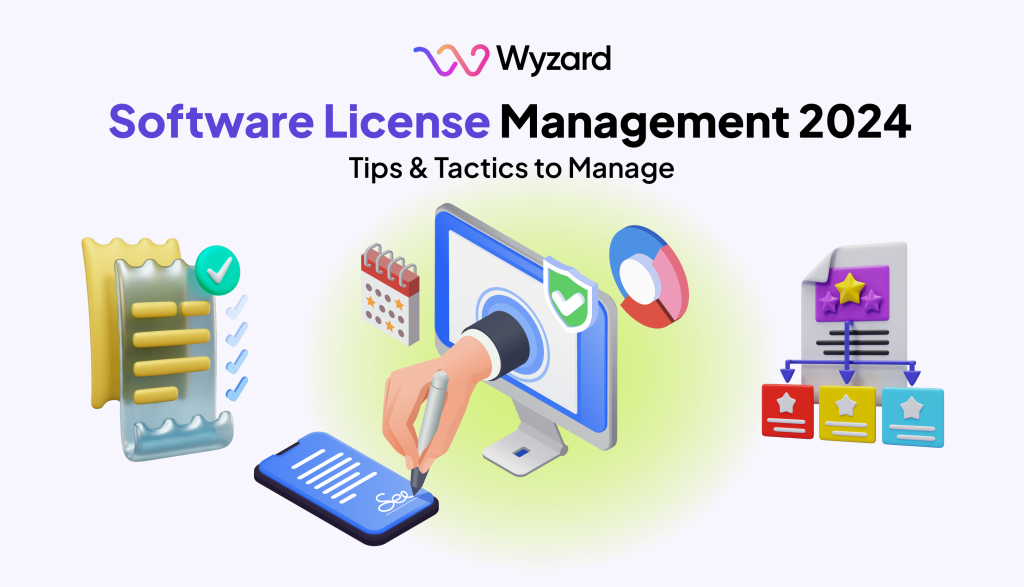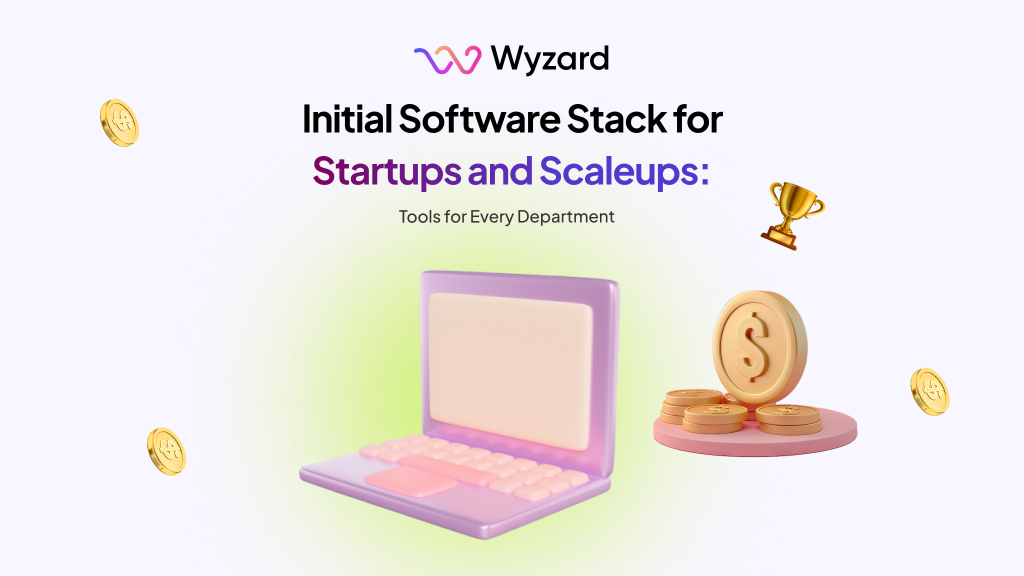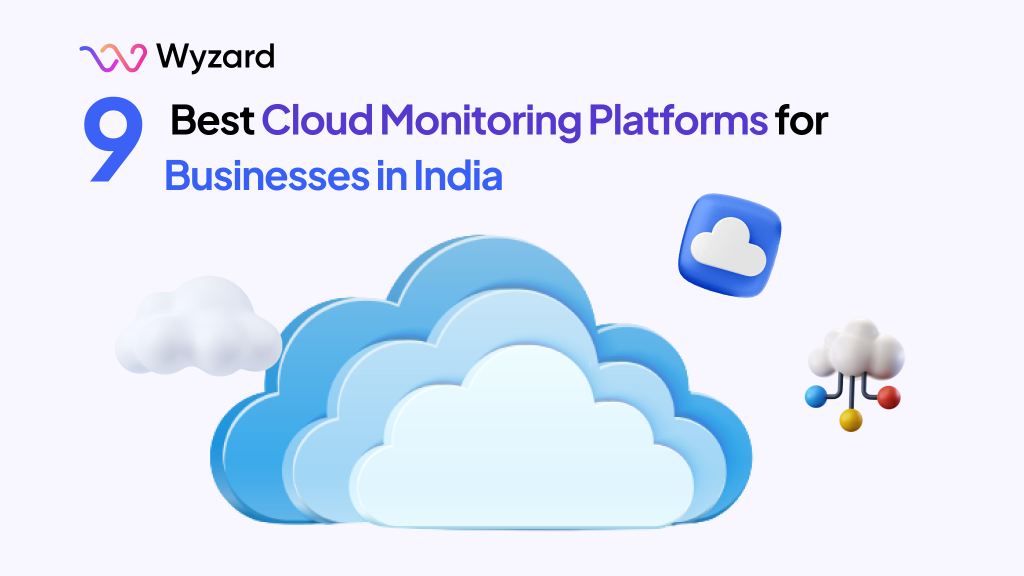SaaS products have changed how organisations work. For every possible question of efficiency, there is a developed or developing ...
SaaS Spend Optimization: 10 Proven Ways to Reduce Software Costs
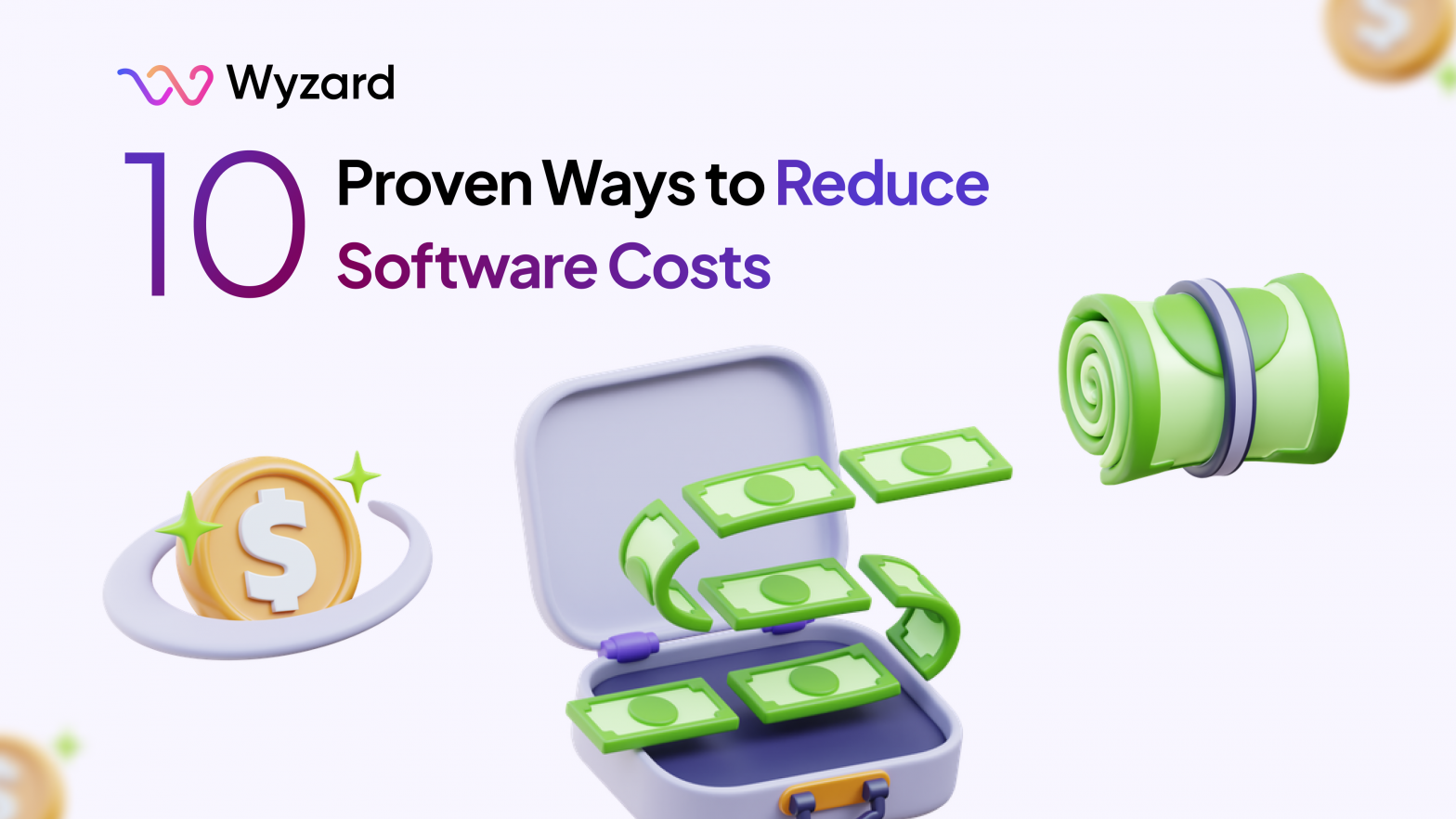
Let’s talk about something that’s been keeping a lot of businesses up at night—increasing SaaS costs. Those subscription fees add up quickly!
According to recent reports, 57% of IT teams are feeling the pressure to cut back on their SaaS spending. And it’s not hard to see why. While shifting to SaaS can potentially reduce IT maintenance costs by 16.1%, the SaaS inflation rate is a staggering 3.5 times higher than the overall market inflation in the USA.
In 2022 alone, large SaaS enterprises hiked their prices by an average of 7.9%, with small companies raising them by 6.3% and mid-sized firms by 6.2%. That’s a lot of extra dough you’re forking out for those fancy software subscriptions.
But here’s the thing – you can’t just go around slashing your tech spending without any direction or planning. The pandemic taught us that technology is the way to future-proofing our businesses. On average, IT and tech expenses are the second or third-largest budget line for most organizations. So, cutting costs in this area requires a balance and a strategic approach.
In this blog, we discuss 10 strategies to reduce software costs. But before we get into the nitty-gritty of things, let’s dive a little deeper into why reduce your software cost.
Why must you optimize your software cost?
Let’s be honest, managing software costs isn’t exactly the most exciting part of running a business.
However, optimizing your SaaS spend is crucial for your organization’s long-term success—and we’re not just talking about saving a few bucks.
Reducing your software cost helps you:
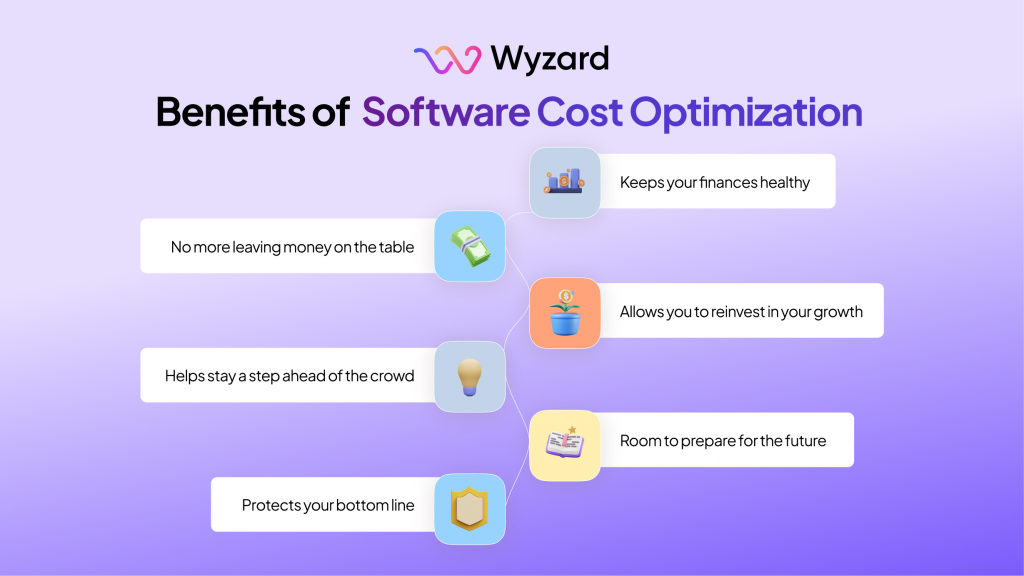
1. Keep your finances healthy
First things first, optimizing your SaaS spend is all about maintaining financial stability. Think about it: software subscriptions can quickly add up, especially if you’ve got multiple tools doing the same job or licenses going unused. By taking control of your SaaS stack, you can cut out the waste and prevent those pesky budget overruns that can really throw challenges toward your plans.
2. Stop leaving money on the table
But it’s not just about saving money; it’s about maximizing the value of your technology investments. You’re spending good money on these software solutions to boost productivity and drive growth, right? Well, if you’re not using them to their full potential, you’re essentially leaving cash on the table.
Optimizing your SaaS spend ensures you’re squeezing every last drop of value out of those subscriptions.
3. Reinvest in your growth
Now, here’s the really exciting part: those cost savings you’ll achieve by optimizing your SaaS spend? They can be reinvested right back into your business.
We’re talking about funding new projects, exploring new markets, or even hiring top talent. Having extra cash to spare for growth will always produce better outcomes than giving it to a software vendor for no reason at all.
4. Stay a step ahead of the crowd
Agility has become a crucial aspect for businesses to maintain irrespective of their size and industry. By streamlining your SaaS stack and optimizing costs, you’ll be able to pivot strategies, adapt to new technologies, and respond to market changes with ease. A lean software ecosystem keeps you nimble and ready for whatever comes your way.
5. Prepare for the future
Speaking of the future, optimizing your SaaS spend now will pay dividends down the line. As your business grows, so will your software needs.
But with a solid foundation of tech cost optimization in place, you’ll be able to scale those technology investments smoothly, without any unnecessary bloat or waste holding you back.
6. Protect your bottom line
Finally, let’s talk about risk mitigation. Uncontrolled software costs can be a ticking time bomb for your finances. By getting a handle on your software spend, you’ll create a buffer that can help you tackle economic storms, supply chain disruptions, or any other curveballs your industry throws your way.
So, optimizing your SaaS spend isn’t just a nice-to-have; it’s a mission-critical task that can impact everything from your finances to your growth potential.
10 Tried-and-tested ways to reduce your software cost
Let’s face it – software subscriptions can quickly become a black hole for your budget if you’re not careful.
But don’t worry, with a few strategic moves, you can take control of your SaaS spend and keep those costs in check.
Here are ten proven tactics to help you do just that:
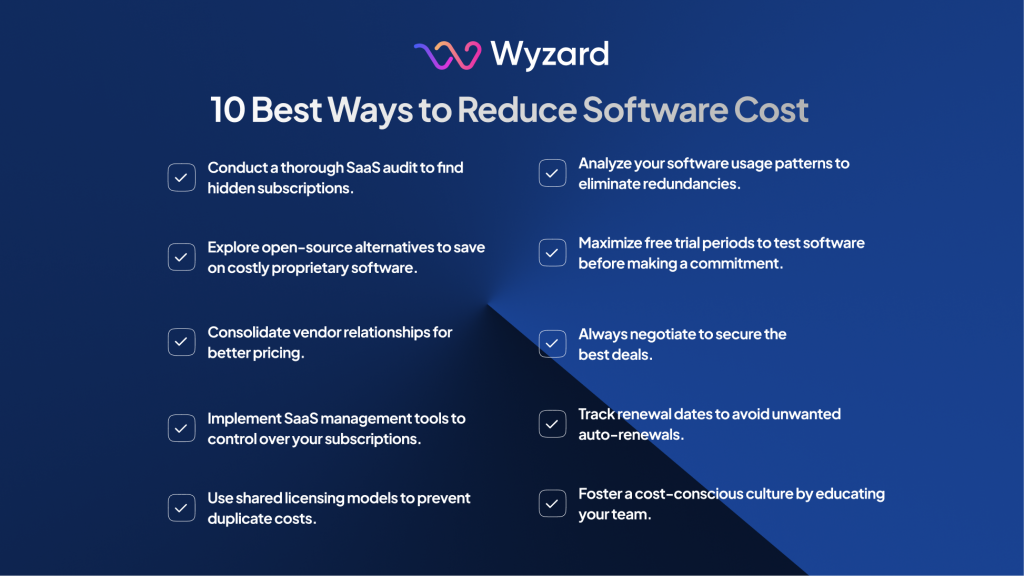
1. Conduct a SaaS audit
The first step to reining in your software spending is to get a clear picture of what you’re actually paying for.
Chances are, your team is subscribed to way more apps and tools than you realize. That’s why conducting a comprehensive SaaS audit is so critical.
Dig deep and find every single subscription, from project management tools to marketing software and everything in between.
This visibility will help you identify redundancies, underutilized licenses, and opportunities for consolidation.
2. Analyze software usage pattern
Understanding actual software usage patterns is key to optimizing costs. Many organizations unknowingly overpay for licenses that aren’t fully utilized.
By analyzing how teams interact with different software across departments, you can find areas of underutilization or redundancy. This insight allows you to downgrade licenses to more suitable tiers, reallocate resources to high-demand areas, or eliminate unnecessary tools altogether.
With SaaS spend management tools like Wyzard, you can get granular visibility into real usage data, rather than relying on assumptions. This allows you to right-size your software investments without compromising productivity—ensuring you pay only for what you truly need.
3. Explore open-source alternatives
Who says you have to break the bank for quality software? Open-source solutions can be a cost-effective alternative to pricey proprietary applications.
Thanks to the collaborative efforts of dedicated developers, many open-source tools rival (or even surpass) their commercial counterparts in terms of features and reliability.
Plus, they’re typically free to use and modify, making them a budget-friendly option worth considering.
4. Leverage free trial period
Making the most of trial periods is a smart way to cut software expenses. Before committing, sign up for trials and put potential solutions through their paces.
Encourage cross-functional teams to test-drive the software, identifying strengths and weaknesses. This collaborative evaluation ensures you only invest in tools that truly meet your needs, avoiding costly missteps.
Additionally, trials provide negotiation leverage—if the software proves valuable, use the trial experience to negotiate better pricing or customized packages aligned with your budget and usage patterns.
By thoroughly vetting software during these complimentary periods, you can make informed decisions and potentially save thousands.
5. Consolidate vendor relationships
If your software stack is a hodgepodge of solutions from various vendors, it might be time to consolidate. By streamlining your vendor relationships and bundling services, you can often negotiate better pricing and simplify contract management. Plus, with fewer vendors to juggle, you’ll likely experience improved collaboration and support.
6. Negotiate, negotiate, negotiate!
Don’t just accept the default pricing and terms when it comes to software subscriptions. Flex those negotiation muscles and see what deals you can strike with your vendors.
Leverage your organization’s buying power, timing renewals strategically, and don’t be afraid to play hardball—more often than not you’ll end up reducing the software cost.
And it’s almost guaranteed if you use Wyzard for SaaS Procurement. The experts here analyze your buying power and, with the help of AI-based insights, get the best deal possible for you.
7. Implement SaaS management tools
Trying to scrutinize all your software subscriptions manually comes with headaches (and it won’t really solve the overspending problem). That’s why investing in a dedicated SaaS management platform can pay dividends. These tools provide centralized visibility, automate renewal tracking, and even help you optimize license allocation—taking the guesswork out of software cost management.
8. Renew your software subscriptions strategically
Most of us have been blindsided by an auto-renewal for software we barely use. And it’s a costly mistake.
That’s why keeping renewal dates on your radar is so crucial for reining in expenditures. With SaaS contract renewal tools like Wyzard, you can track contract details centrally and receive timely reminders before renewals, so you’re never caught off guard.
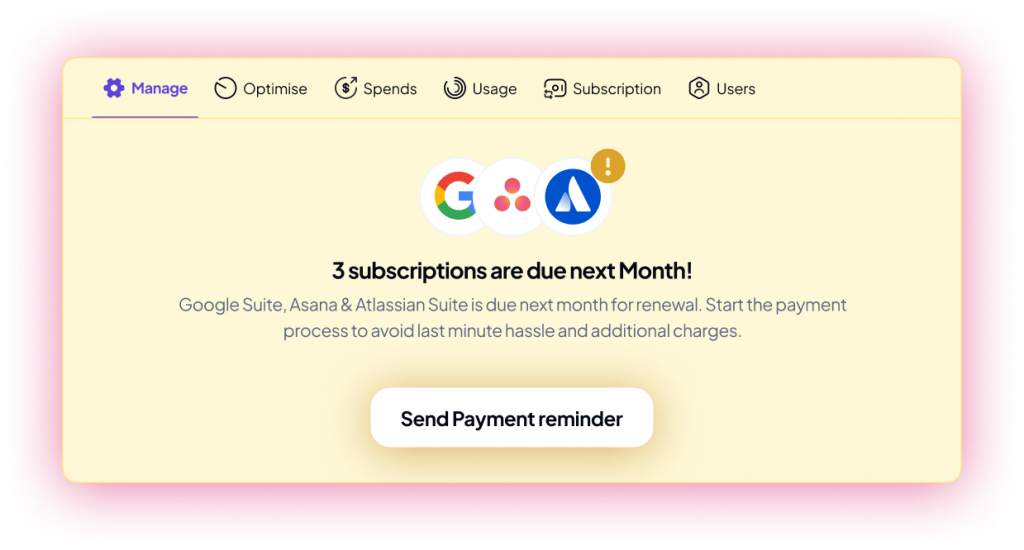
More importantly, that advance notice gives you a prime opportunity to negotiate better terms aligned with your actual needs and usage patterns.
Leverage data on adoption rates to right-size your subscriptions or even explore alternative pricing models. Just don’t wait until the last minute—start prepping those renewal conversations at least 90 days out for maximum leverage.
9. Go for the shared licensing strategy
You know that fancy project management tool your marketing team swears by? Chances are, the sales team is paying for their own licenses too, despite only using it occasionally. That’s just money down the drain.
Instead of springing for individual licenses across departments, why not implement a shared licensing model? This approach ensures software access goes to the teams that actually need it, based on real-time usage data—not arbitrary departmental quotas.
But shared licensing isn’t just about cost savings; it also improves collaboration and resource optimization across your org. By encouraging teams to coordinate their software needs, you nurture a culture of shared resources and unified planning.
10. Foster a cost-conscious culture
At the end of the day, effective software cost optimization requires buy-in from everyone in your organization.
Encourage a cost-conscious mindset by educating your team on the importance of responsible software usage and procurement.
You should also establish clear policies and approval processes to prevent rogue software purchases and celebrate wins when you achieve significant cost savings.
Remember, optimizing your software spend is an ongoing process that requires diligence and adaptability.
But by implementing these strategies, you’ll be well on your way to controlling those costs and freeing up resources for other priorities.
Wyzard helps you with data-driven cost reduction without compromises
Reducing software costs is a laudable goal, but some traditional cost-cutting measures can backfire spectacularly.
Indiscriminate slashing often leads to quality compromises, security vulnerabilities, and a dip in employee productivity as teams struggle with subpar tools or clunky workarounds.
The root cause of these risks? Decisions are based on guesswork rather than hard data. A “spray-and-pray” approach to software rationalization often leads to disastrous outcomes, leaving you with an inefficient, piecemeal tech stack that does more harm than good.
And this is where Wyzard comes in!
By diving deep into your current software stack, analyzing granular usage patterns, and scrutinizing expenditure data, Wyzard provides tailored recommendations that align with your unique needs and budgets. Every suggestion is backed by empirical evidence and careful consideration.
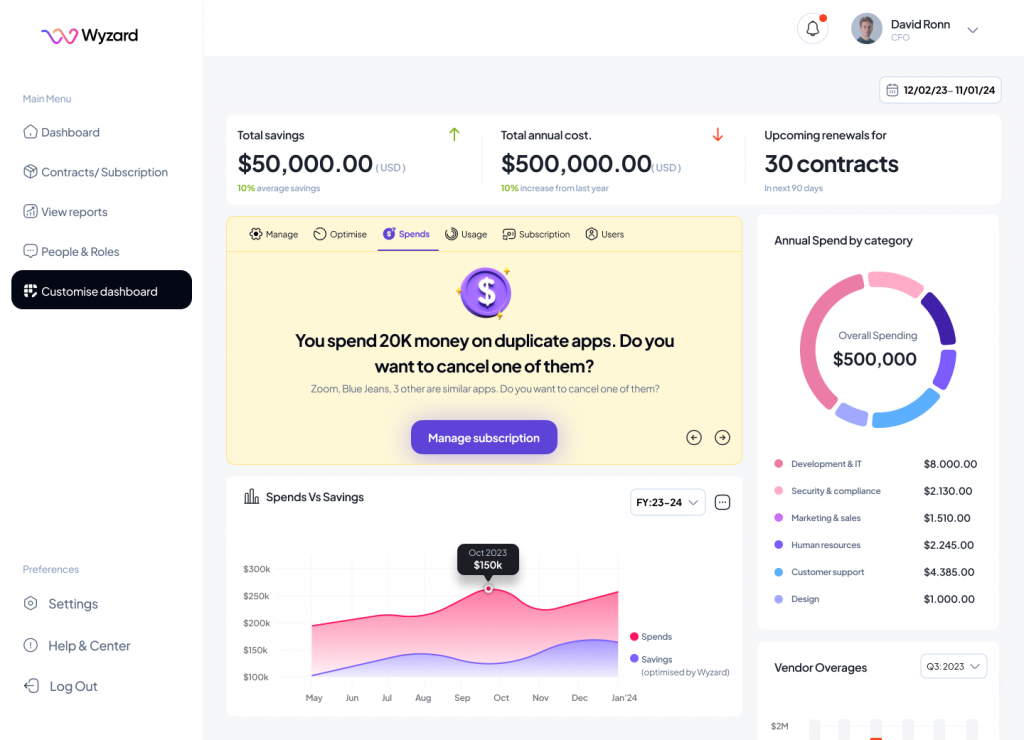
Wyzard’s data-driven approach ensures that any software changes or consolidations maintain feature parity so your teams never lose critical functionality. And with a keen eye on compliance and security standards, you can rest assured that cost optimization won’t come at the expense of vulnerabilities or regulatory risks.
Other blogs
The latest industry news, interviews, technologies, and resources.
August 8, 2024
Initial Software Stack for Startups and Scaleups: Tools for Every Department
Starting a business is exhilarating, but it comes with its fair share of challenges. One of the biggest hurdles? ...

9 Best Cloud Monitoring Platforms for Businesses in India
Cloud monitoring is essential for businesses using cloud services. It helps you track and manage your cloud infrastructure, ensuring ...

Subscribe
Today!
Error: Contact form not found.
Subscribe to learn about new product features, the latest in technology, solutions, and updates.

